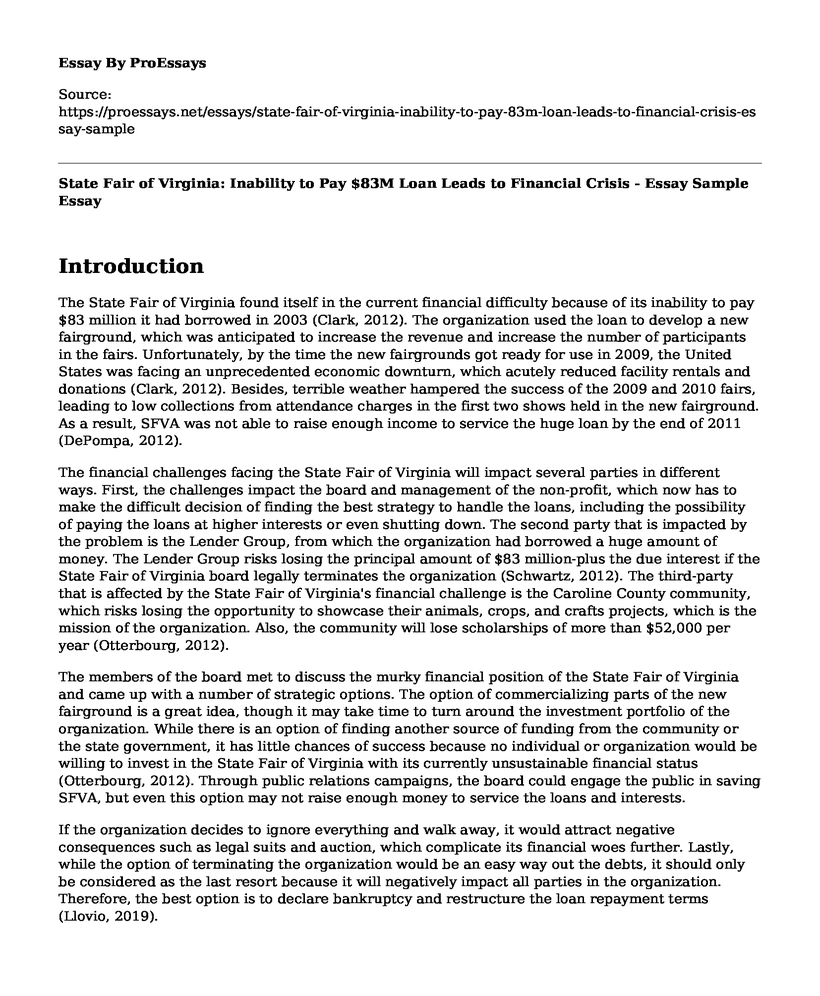Introduction
The State Fair of Virginia found itself in the current financial difficulty because of its inability to pay $83 million it had borrowed in 2003 (Clark, 2012). The organization used the loan to develop a new fairground, which was anticipated to increase the revenue and increase the number of participants in the fairs. Unfortunately, by the time the new fairgrounds got ready for use in 2009, the United States was facing an unprecedented economic downturn, which acutely reduced facility rentals and donations (Clark, 2012). Besides, terrible weather hampered the success of the 2009 and 2010 fairs, leading to low collections from attendance charges in the first two shows held in the new fairground. As a result, SFVA was not able to raise enough income to service the huge loan by the end of 2011 (DePompa, 2012).
The financial challenges facing the State Fair of Virginia will impact several parties in different ways. First, the challenges impact the board and management of the non-profit, which now has to make the difficult decision of finding the best strategy to handle the loans, including the possibility of paying the loans at higher interests or even shutting down. The second party that is impacted by the problem is the Lender Group, from which the organization had borrowed a huge amount of money. The Lender Group risks losing the principal amount of $83 million-plus the due interest if the State Fair of Virginia board legally terminates the organization (Schwartz, 2012). The third-party that is affected by the State Fair of Virginia's financial challenge is the Caroline County community, which risks losing the opportunity to showcase their animals, crops, and crafts projects, which is the mission of the organization. Also, the community will lose scholarships of more than $52,000 per year (Otterbourg, 2012).
The members of the board met to discuss the murky financial position of the State Fair of Virginia and came up with a number of strategic options. The option of commercializing parts of the new fairground is a great idea, though it may take time to turn around the investment portfolio of the organization. While there is an option of finding another source of funding from the community or the state government, it has little chances of success because no individual or organization would be willing to invest in the State Fair of Virginia with its currently unsustainable financial status (Otterbourg, 2012). Through public relations campaigns, the board could engage the public in saving SFVA, but even this option may not raise enough money to service the loans and interests.
If the organization decides to ignore everything and walk away, it would attract negative consequences such as legal suits and auction, which complicate its financial woes further. Lastly, while the option of terminating the organization would be an easy way out the debts, it should only be considered as the last resort because it will negatively impact all parties in the organization. Therefore, the best option is to declare bankruptcy and restructure the loan repayment terms (Llovio, 2019).
The first step that the State Fair of Virginia Board of Directors should take is to meet their creditors, reaffirm its commitment to pay all the debts and seek their indulgence to restructure the loans. If it fails to persuade the Lender Group to restructure out of a goodwill, the next step is for the board to take advantage of the law governing non-profits by declaring bankruptcy according to chapter 11 (Llovio, 2019). That would give it legal ground to restructure and get more convenience in terms of time.
References
Clark, M. (2012, May 31). Troubled Times at the State Fair. The Pew Charitable Trusts | The Pew Charitable Trusts. https://www.pewtrusts.org/en/research-and-analysis/blogs/stateline/2012/05/31/troubled-times-at-the-state-fair
DePompa, R. (2012, June 19). 12 Investigates State Fair of Virginia Bankruptcy. https://www.nbc12.com/story/18575673/12investigates-state-fair-bankruptcy/
Llovio, L. (2019, September 18). State Fair of Virginia's Operator Files for Bankruptcy. Richmond Times-Dispatch. https://www.richmond.com/business/state-fair-of-virginia-s-operator-files-for-bankruptcy/article_e43c7f6d-f643-508c-b47c-633d91e5e353.html
Otterbourg, Y. K. (2012, August 30). Virginia's State Fair is saved, but what will it become? The Washington Post. https://www.washingtonpost.com/lifestyle/magazine/virginias-state-fair-is-saved-but-what-will-it-become/2012/08/28/5e59ba9a-ddaf-11e1-af1d-753c613ff6d8_story.html
Schwartz, M. (2012, March 8). State Fair Shuts Down After 150 Years. Richmond BizSense. https://richmondbizsense.com/2012/03/08/state-fair-shuts-down-after-150-years/
Cite this page
State Fair of Virginia: Inability to Pay $83M Loan Leads to Financial Crisis - Essay Sample. (2023, Apr 07). Retrieved from https://proessays.net/essays/state-fair-of-virginia-inability-to-pay-83m-loan-leads-to-financial-crisis-essay-sample
If you are the original author of this essay and no longer wish to have it published on the ProEssays website, please click below to request its removal:
- Medical and Insurance Options Essay
- Protecting a Business From Adverse Currency Movements
- Tax on Soda and Sugary Drinks Essay Example
- Essay Sample on Comprehensive Annual Financial Report
- Tariffs: A Major Trade Protectionism Tool - Essay Sample
- Umpqua Bank: Dysfunctional Operations Management System Leads to Confusion - Essay Sample
- Healthcare Industry: Structure and Trends - Free Report Sample







